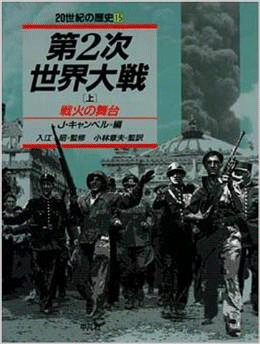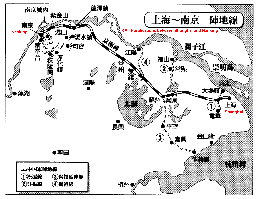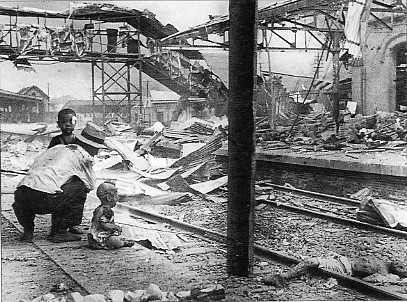
This photo was was photographed by Wang Xiao-ting (¤¬à, a.k.a. gNewsreelh Wang) sometime after the bombardment of the Shanghai South Station by Japanfs planes that took place at 3:00 p.m., August 28, 1937.
By this time, the Chinese KMT Forces swarmed in the outskirts of Shanghai City and its 87th and 88th Divisions commenced their assaults on August 13 from the northwest corner of the city against the Japanese Marine Corps stationed around the Eight Letters Bridge District (ª´næ) for the defense of Japanese residents in Shanghai.
Against the disparity of the troop sizes, which was 10 to 1, the Japanese Marine Corps fiercely fought the battles while asking the Army HQ in Tokyo to send more troops to Shanghai. Out of the fear of the possible recurrence of the Tsushu Massacre iÊBsEjthat took the lives of 300 Japanese residents in China, Tokyo decided to send two Army divisions (Nagoya 11th and Zentsuji 11th) to Shanghai. The Battle of Shanghai escalated into a full-scale war between the Chinese KMT Forces and the Japanese Army.
On August 14, Chinese fighter planes appeared over the sky of Shanghai and one of the planes tried to bombard the Battleship Izumo, a Japanese Navy ship stationed along the Japanese Concession. Fired back from the battleship, the panicked pilot mistakenly bombarded the nearby entertainment district and hotels. The Battleship Izumo was intact and there was no damage. Other Chinese planes bombarded the French Concession and the International Concession. This intentional bombardment of the Chinese KMT Air Force against its own people caused the death toll of 1,741 and 1,868 injured. Most of them were Chinese. (Source:China Yearbook 1938)
Pitched battles followed with no end in sight and, on August 28, in a frantic attempt to cut-off the enemy supply route, Japanfs fighter planes bombarded the Shanghai South Station, then the supply depot of the Chinese KMT Forces.
BTW, there are at least two other different versions of this gBlack Saturday Crying Babyh photo.
One appears in a book titled gHistory of the 20th Century: World War IIh edited by John Campbell (below) and the other appears in the gBattle of Chinah directed by Frank Capra.
¡ History of the 20th Century (p.23)
 |
|
¡ Battle of China (21:25-24:27)
Click the image below to watch the movie, although the narration is total falsification and propaganda.

-
Furthermore, there seems to be another photo that appears to be part of the movie of the gBattle of China.h You can find the scene in gRape of Nanking (3).h
Click the image below to watch the movie.
¡ Rape of Nanking (3) (11:48)
In the movie, the baby suddenly stops crying and watches the place from where the smoke is coming as if he noticed someting was there.

Summation:
You may wonder why there are some different scenes for the photo that is supposed to be the documentary.
The documentary photo is a snapshot of one scene the photographer has come across by chance.
However:
- The dark colored boy in the gHistory of the 20th Centuryh disappeared in other photos and movies;
- In the Battle of China, the Chinese-looking man brings the child out of the railway yard of the station;
- In the Rape of Nanking (3), there seems to be something that generates white smoke on the childfs left side.
It may be a smoke canister, which creates the impact of the dark scilhouette of the child; and, - The person with white hat might be Newsreel Wang.
 |
Conveniently Placed Toys
©Click the image to find more Staged Photo Techniques |


